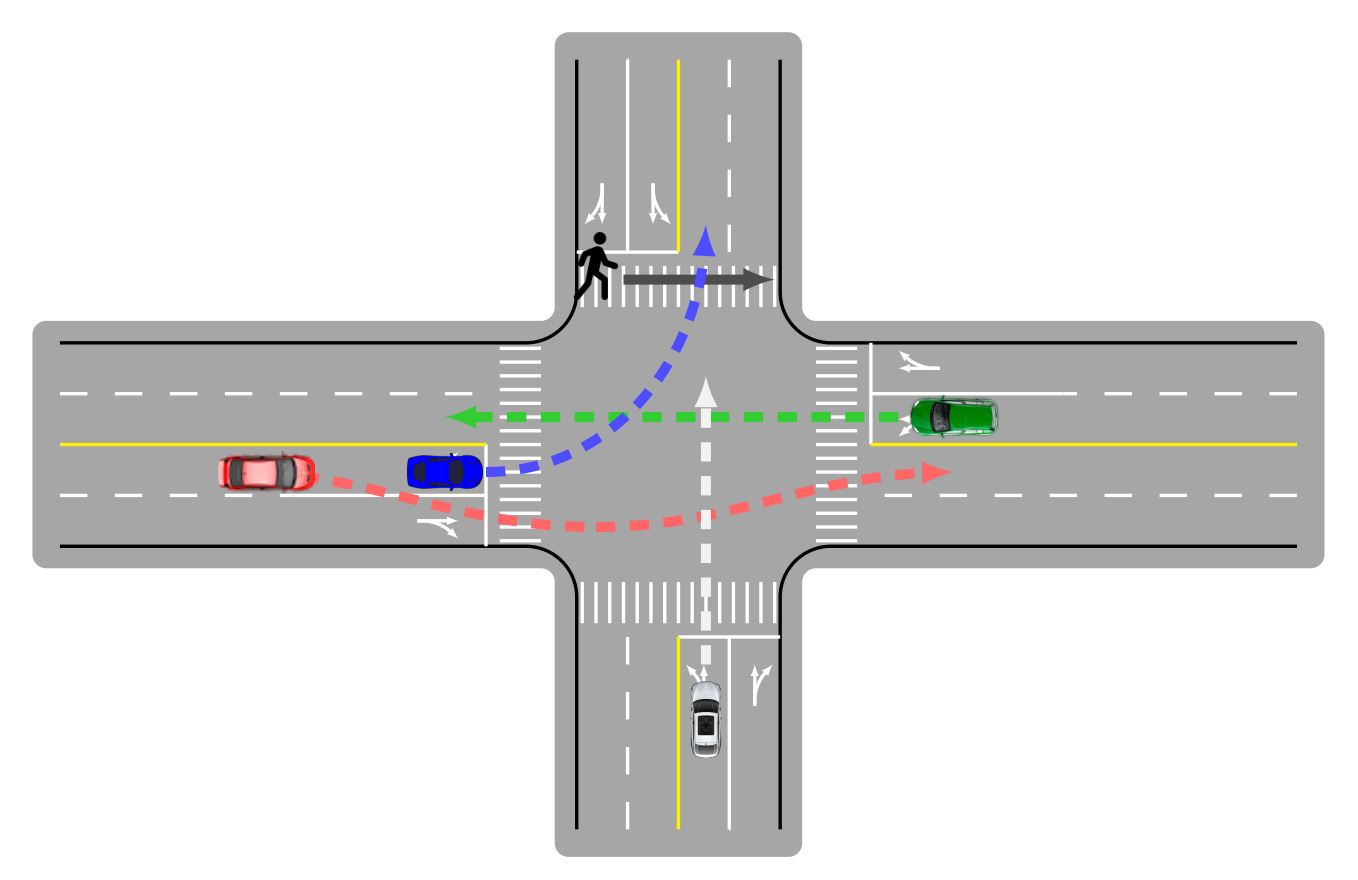About Me
I’m a final-year Ph.D. candidate at McGill University under the supervision of Prof. Lijun Sun. I was a visiting researcher at the Robotics Institute, Carnegie Mellon University in 2023 under the supervision of Prof. Changliu Liu, and at the Department of Mechanical Engineering in 2018. Additionally, I conducted research at the Department of Mechanical Engineering, UC Berkeley from 2019 to 2020 under the supervision of Prof. Masayoshi Tomizuka.
My research focuses on Bayesian inference, spatiotemporal modeling, traffic flow theory, and multi-agent interaction modeling within intelligent transportation systems, with an emphasis on bridging the gap between theoretical modeling and practical traffic simulation through advanced statistical techniques with appropriate uncertainty quantification. My motivation lies in advancing the understanding of human driving behaviors to improve microscopic traffic simulations, ultimately contributing to safer and more efficient transportation systems.
👋 Please feel free to contact me to schedule a quick discussion if you are interested in collaborating with me.
📢 I am actively seeking a postdoctoral position focused on topics such as stochastic modeling and simulation of human driving behaviors (beyond traditional car-following scenarios), social interaction modeling (including both drivers and pedestrians), and Bayesian inference. If my research interests align with your group, I would be excited to connect!
News
- New! New preprint alert! Our paper “Markov Regime-Switching Intelligent Driver Model for Interpretable Car-Following Behavior” is now available on arXiv: 2506.14762. Please check it out!
- New! I am delighted to give an online talk “Stochastic Modeling and Simulations of Car-Following Behaviors” at MIT (invited by Dr. Xinyu Chen with the Department of Urban Studies and Planning).
- New! Our paper “Forecasting sparse movement speed of urban road networks with nonstationary temporal matrix factorization” was accepted to Transportation Science. [TranSci] [preprint] [arXiv] [code] [blog I] [blog II] [slides]
- New! I received the CIRRELT Doctoral Scholarship of Excellence - Final Stages. Thanks, CIRRELT!
Featured Research
- Traffic Flow Theory & Traffic Simulations
- Bayesian calibration of car-following models (IEEE T-ITS)
- Calibrating Car-Following Models via Bayesian Dynamic Regression (ISTTT25 & TR Part C)
- Multi-Agent Social Interactions & Human Driving Behaviors
- Social interactions for autonomous driving: A review and perspectives (Foundations and Trends® in Robotics)
- Spatiotemporal learning of multivehicle interaction patterns in lane-change scenarios (IEEE T-ITS)
- Spatiotemporal Modeling & Interpretable pattern discovery
- Discovering dynamic patterns from spatiotemporal data with time-varying low-rank autoregression (IEEE TKDE)
- Forecasting sparse movement speed of urban road networks with nonstationary temporal matrix factorization (Transportation Science)
Bayesian Calibration of the Car-Following Models
Chengyuan Zhang and Lijun Sun. IEEE Transaction on Intelligent Transportation Systems.
[Abstract]
Accurate calibration of car-following models is essential for understanding human driving behaviors and implementing high-fidelity microscopic simulations. This work proposes a memory-augmented Bayesian calibration technique to capture both uncertainty in the model parameters and the temporally correlated behavior discrepancy between model predictions and observed data. Specifically, we characterize the parameter uncertainty using a hierarchical Bayesian framework and model the temporally correlated errors using Gaussian processes. We apply the Bayesian calibration technique to the intelligent driver model (IDM) and develop a novel stochastic car-following model named memory-augmented IDM (MA-IDM). To evaluate the effectiveness of MA-IDM, we compare the proposed MA-IDM with Bayesian IDM in which errors are assumed to be i.i.d., and our simulation results based on the HighD dataset show that MA-IDM can generate more realistic driving behaviors and provide better uncertainty quantification than Bayesian IDM. By analyzing the lengthscale parameter of the Gaussian process, we also show that taking the driving actions from the past five seconds into account can be helpful in modeling and simulating the human driver’s car-following behaviors.- Access our preprint via: GP+IDM [IEEE TITS] [arXiv] and AR+IDM [TR PartC] [arXiv] .
- Codes are available: [Github repo].
- Presentation: [recording] [poster].
Spatiotemporal Learning of Multivehicle Interaction Patterns in Lane-Change Scenarios
Chengyuan Zhang, Jiacheng Zhu, Wenshuo Wang, and Junqiang Xi. IEEE Transaction on Intelligent Transportation Systems.
[Abstract]
Interpretation of common-yet-challenging interaction scenarios can benefit well-founded decisions for autonomous vehicles. Previous research achieved this using their prior knowledge of specific scenarios with predefined models, limiting their adaptive capabilities. This paper describes a Bayesian nonparametric approach that leverages continuous ( i.e., Gaussian processes) and discrete (i.e., Dirichlet processes) stochastic processes to reveal underlying interaction patterns of the ego vehicle with other nearby vehicles. Our model relaxes dependency on the number of surrounding vehicles by developing an acceleration-sensitive velocity field based on Gaussian processes. The experiment results demonstrate that the velocity field can represent the _spatial_ interactions between the ego vehicle and its surroundings. Then, a discrete Bayesian nonparametric model, integrating Dirichlet processes and hidden Markov models, is developed to learn the interaction patterns over the _temporal_ space by segmenting and clustering the sequential interaction data into interpretable granular patterns automatically. We then evaluate our approach in the highway lane-change scenarios using the highD dataset collected from real-world settings. Results demonstrate that our proposed Bayesian nonparametric approach provides an insight into the complicated lane-change interactions of the ego vehicle with multiple surrounding traffic participants based on the interpretable interaction patterns and their transition properties in temporal relationships. Our proposed approach sheds light on efficiently analyzing other kinds of multi-agent interactions, such as vehicle-pedestrian interactions.- Access our paper via: [arXiv] , [paper], or [project website].
- Watch the demos via: [YouTube].
- Code for implementing Gaussian Velocity Field: [Github repo].
- Also check the supplements via: [Spatiotemporal_Appendix.pdf].
Social Interactions for Autonomous Driving: A Review and Perspective
Wenshuo Wang, Letian Wang, Chengyuan Zhang, Changliu Liu, and Lijun Sun. Foundations and Trends in Robotics.

[Abstract]
No human drives a car in a vacuum; she/he must negotiate with other road users to achieve their goals in social traffic scenes. A rational human driver can interact with other road users in a socially-compatible way through implicit communications to complete their driving tasks smoothly in interaction-intensive, safety-critical environments. This paper aims to review the existing approaches and theories to help understand and rethink the interactions among human drivers toward social autonomous driving. We take this survey to seek the answers to a series of fundamental questions: 1) What is social interaction in road traffic scenes? 2) How to measure and evaluate social interaction? 3) How to model and reveal the process of social interaction? 4) How do human drivers reach an implicit agreement and negotiate smoothly in social interaction? This paper reviews various approaches to modeling and learning the social interactions between human drivers, ranging from optimization theory, deep learning, and graphical models to social force theory and behavioral & cognitive science. We also highlight some new directions, critical challenges, and opening questions for future research.- Access our book via: [ebook], [arXiv], or [project website].
An Efficient Parking Solution: A Cam-Linkage Double-Parallelogram Mechanism Based 1-Degrees of Freedom Stack Parking System
Chengyuan Zhang, Xiaomin Zhang, Hongyun Ye, Ming Wei, and Xianxiong Ning. ASME Journal of Mechanisms and Robotics.
- This is a very interesting mechanical work (a.k.a. big toy) that was done during my undergraduate study.
- Access our work via: [ASME JMR].
Thanks & Fundings




